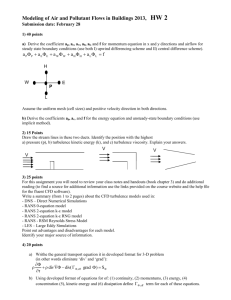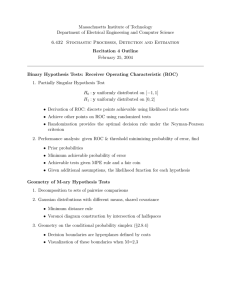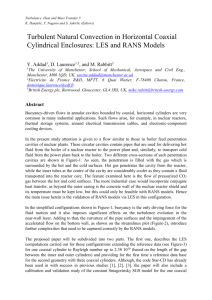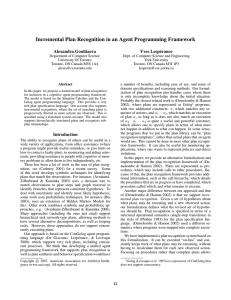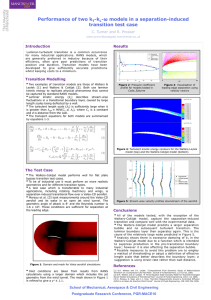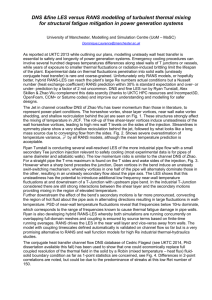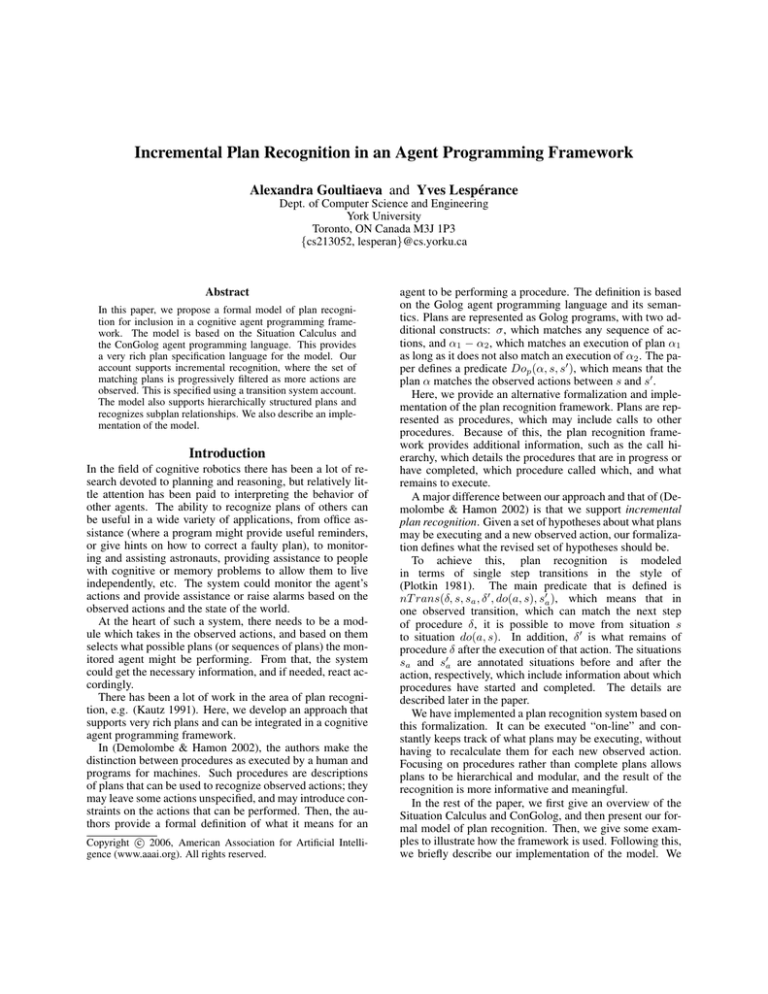
Incremental Plan Recognition in an Agent Programming Framework
Alexandra Goultiaeva and Yves Lespérance
Dept. of Computer Science and Engineering
York University
Toronto, ON Canada M3J 1P3
{cs213052, lesperan}@cs.yorku.ca
Abstract
In this paper, we propose a formal model of plan recognition for inclusion in a cognitive agent programming framework. The model is based on the Situation Calculus and
the ConGolog agent programming language. This provides
a very rich plan specification language for the model. Our
account supports incremental recognition, where the set of
matching plans is progressively filtered as more actions are
observed. This is specified using a transition system account.
The model also supports hierarchically structured plans and
recognizes subplan relationships. We also describe an implementation of the model.
Introduction
In the field of cognitive robotics there has been a lot of research devoted to planning and reasoning, but relatively little attention has been paid to interpreting the behavior of
other agents. The ability to recognize plans of others can
be useful in a wide variety of applications, from office assistance (where a program might provide useful reminders,
or give hints on how to correct a faulty plan), to monitoring and assisting astronauts, providing assistance to people
with cognitive or memory problems to allow them to live
independently, etc. The system could monitor the agent’s
actions and provide assistance or raise alarms based on the
observed actions and the state of the world.
At the heart of such a system, there needs to be a module which takes in the observed actions, and based on them
selects what possible plans (or sequences of plans) the monitored agent might be performing. From that, the system
could get the necessary information, and if needed, react accordingly.
There has been a lot of work in the area of plan recognition, e.g. (Kautz 1991). Here, we develop an approach that
supports very rich plans and can be integrated in a cognitive
agent programming framework.
In (Demolombe & Hamon 2002), the authors make the
distinction between procedures as executed by a human and
programs for machines. Such procedures are descriptions
of plans that can be used to recognize observed actions; they
may leave some actions unspecified, and may introduce constraints on the actions that can be performed. Then, the authors provide a formal definition of what it means for an
c 2006, American Association for Artificial IntelliCopyright gence (www.aaai.org). All rights reserved.
agent to be performing a procedure. The definition is based
on the Golog agent programming language and its semantics. Plans are represented as Golog programs, with two additional constructs: σ, which matches any sequence of actions, and α1 − α2 , which matches an execution of plan α1
as long as it does not also match an execution of α2 . The paper defines a predicate Dop (α, s, s ), which means that the
plan α matches the observed actions between s and s .
Here, we provide an alternative formalization and implementation of the plan recognition framework. Plans are represented as procedures, which may include calls to other
procedures. Because of this, the plan recognition framework provides additional information, such as the call hierarchy, which details the procedures that are in progress or
have completed, which procedure called which, and what
remains to execute.
A major difference between our approach and that of (Demolombe & Hamon 2002) is that we support incremental
plan recognition. Given a set of hypotheses about what plans
may be executing and a new observed action, our formalization defines what the revised set of hypotheses should be.
To achieve this, plan recognition is modeled
in terms of single step transitions in the style of
(Plotkin 1981). The main predicate that is defined is
nT rans(δ, s, sa , δ , do(a, s), sa ), which means that in
one observed transition, which can match the next step
of procedure δ, it is possible to move from situation s
to situation do(a, s). In addition, δ is what remains of
procedure δ after the execution of that action. The situations
sa and sa are annotated situations before and after the
action, respectively, which include information about which
procedures have started and completed. The details are
described later in the paper.
We have implemented a plan recognition system based on
this formalization. It can be executed “on-line” and constantly keeps track of what plans may be executing, without
having to recalculate them for each new observed action.
Focusing on procedures rather than complete plans allows
plans to be hierarchical and modular, and the result of the
recognition is more informative and meaningful.
In the rest of the paper, we first give an overview of the
Situation Calculus and ConGolog, and then present our formal model of plan recognition. Then, we give some examples to illustrate how the framework is used. Following this,
we briefly describe our implementation of the model. We
conclude the paper with a discussion of the novel features
and limitations of our account, and provide suggestions for
future work.
The Situation Calculus and ConGolog
The technical machinery that we use to define high-level
program execution is based on that of (De Giacomo,
Lespérance, & Levesque 2000). The starting point in the
definition is the situation calculus (McCarthy & Hayes
1979). We will not go over the language here except to note
the following components: there is a special constant S0
used to denote the initial situation, namely that situation in
which no actions have yet occurred; there is a distinguished
binary function symbol do where do(a, s) denotes the successor situation to s resulting from performing the action a;
relations whose truth values vary from situation to situation,
are called (relational) fluents, and are denoted by predicate
symbols taking a situation term as their last argument. There
is a special predicate P oss(a, s) used to state that action a
is executable in situation s.
Within this language, we can formulate domain theories
which describe how the world changes as the result of the
available actions. Here, we use action theories of the following form:
• Axioms describing the initial situation, S0 .
• Action precondition axioms, one for each primitive action
a, characterizing P oss(a, s).
• Successor state axioms, one for each fluent F , which characterize the conditions under which F (x, do(a, s)) holds
in terms of what holds in situation s; these axioms may
be compiled from effects axioms, but provide a solution
to the frame problem (Reiter 1991).
• Unique names axioms for the primitive actions.
• A set of foundational, domain independent axioms for situations Σ as in (Reiter 2001).
Next we turn to programs. The programs we consider
here are based on the ConGolog language defined in (De Giacomo, Lespérance, & Levesque 2000), an extension of
Golog (Levesque et al. 1997a), providing a rich set of programming constructs as follows:
α,
primitive action
φ?,
wait for a condition
sequence
δ1 ; δ2 ,
nondeterministic branch
δ1 | δ2 ,
π x. δ,
nondeterministic choice of argument
nondeterministic iteration
δ∗ ,
conditional
if φ then δ1 else δ2 endIf,
while φ do δ endWhile,
while loop
concurrency with equal priority
δ1 δ2 ,
concurrency with δ1 at a higher priority
δ1 δ2 ,
concurrent iteration
δ || ,
φ → δ ,
interrupt
p(θ),
procedure call
Among these constructs, we notice the presence of of nondeterministic constructs. These include (δ1 | δ2 ), which
nondeterministically chooses between programs δ1 and δ2 ,
π x. δ, which nondeterministically picks a binding for the
variable x and performs the program δ for this binding of x,
and δ ∗ , which performs δ zero or more times. Also notice
that ConGolog includes constructs for dealing with concurrency. In particular (δ1 δ2 ) denotes the concurrent execution (interpreted as interleaving) of the programs δ1 and
δ2 . We refer the reader to (De Giacomo, Lespérance, &
Levesque 2000) for a detailed account of ConGolog.
Golog and its successors have been used to build a number
of applications. These include a demonstration mail delivery robot at Toronto and York Universities, a robot museum
guide at University of Bonn (Burgard et al. 1998), a character specification program for computer animation (Funge
1998), and others.
In (De Giacomo, Lespérance, & Levesque 2000), a single step transition semantics in the style of (Plotkin 1981)
is defined for ConGolog programs. Two special predicates
T rans and F inal are introduced. T rans(δ, s, δ , s ) means
that by executing program δ starting in situation s, one can
get to situation s in one elementary step with the program δ remaining to be executed. F inal(δ, s) means that program
δ may successfully terminate in situation s.
Offline executions of programs, which are the kind of
executions originally proposed for Golog and ConGolog
(Levesque et al. 1997b; De Giacomo, Lespérance, &
Levesque 2000), are characterized using the Do(δ, s, s )
predicate, which means that there is an execution of program δ (a sequence of transitions) that starts in situation s
and terminates in situation s :
Do(δ, s, s ) = ∃δ .T rans∗ (δ, s, δ , s ) ∧ F inal(δ , s ),
def
where T rans∗ is the reflexive transitive closure of
T rans. An offline execution of δ from s is a sequence of actions a, . . . , an such that: D ∪ C |=
Do(δ, s, do(an , . . . , do(a1 , s) . . .)), where D is an action
theory as mentioned above, and C is a set of axioms defining the predicates T rans and F inal and the encoding of
programs as first-order terms (De Giacomo, Lespérance, &
Levesque 2000).
Formalizing plan recognition
Recognizing a plan means that given a sequence of observed
actions, the system must be able to determine which plan(s)
the user may be following. The framework described here
relies on a plan library, which details the possible plans as
procedures in ConGolog. Depending on the application, the
plan library may also include faulty plans to allow the system to recognize common errors in plans and offer advice for
correcting them. Given the sequence of actions performed,
the system should be able to provide the following information: the plan that the user is currently following; the stage
in the plan that the user is following – what has already been
done and what remains to be done; and which procedures
that plan is part of – is the user doing it as part of a larger
plan?
The framework is specified in terms of ConGolog, to
which a few extensions are made. Note that what is described below could have alternatively been done by modifying the semantics of the language. The following formalization is designed to build on top of the existing framework
as much as possible.
First, we introduce two special primitive actions:
startP roc(name(args)) and endP roc(name(args)).
These are annotation actions, present only in the plan
library, but never actually observed. The two actions
are used to represent procedure invocation and completion. It is assumed that every procedure that we
want to distinguish in the plan library starts with the
action startP roc(name(args)) and ends with the action
endP roc(name(args)), where name is the name of the
procedure in which the actions occur, and args are its
arguments. This markup can be generated automatically
given a plan library.
Our transition system semantics for plans fully supports
concurrency. However, when there is concurrency between
procedures in the plan library, the annotated situation as currently defined is no longer sufficient to determine which
procedure an observed action belongs to. Additional annotations would have to be used to disambiguate this. Concurrency can also lead to a huge increase in the number of
plan execution hypotheses, so control mechanisms would
be needed. Thus, we do not consider the case of concurrency between procedures in the plan library in this paper
and leave the problem for future work.
After the inclusion of the annotation actions, for each sequence of observable actions there are two situations: the
real (observed) situation, and the annotated situation, which
includes the actions startP roc and endP roc. Given the
annotated situation, it is straightforward to obtain the state
of the execution stack (which procedures are currently executing), determine what actions were executed by which
procedures, and determine the remaining plan. An action startP roc(proc) means that the procedure proc was
called, and should be added to the stack. The action
endP roc(proc) signals that the last procedure has terminated, and should be removed from the stack.
Note that for a given real situation, there may be multiple
annotated situations that would match it. Each of those situations would show a different possible execution path in the
plan library. For example, if the plan library contained the
following procedures:
proc p1
proc p2
startP roc(p1); a; b; endP roc(p1) endProc
startP roc(p2); a; c; endP roc(p2) endProc
then the real situation do(a, S0 ) would have
two possible annotated situations that would
and
match
it:
do(a, do(startP roc(p1), S0 ))
do(a, do(startP roc(p2), S0 )).
In this context, the plan recognition problem reduces to
the following: given the observed situation and a plan library, find the possible annotated situations.
As mentioned in (Demolombe & Hamon 2002), in many
situations it would be useful for the procedures to leave some
actions unspecified, or to place additional constraints on the
plans. So, two new constructs, discussed in more detail later,
are introduced. The first is anyBut(actionList), which allows one to execute an arbitrary primitive action which is
not in its argument list. For example, anyBut([b, d]) would
match actions a or c, but not b or d. It is a useful shorthand to
write general plans which might involve unspecified steps.
For example, a plan might specify that a certain condition
needs to hold for its continuation, but leave unspecified how
the condition was achieved.
The second construct is minus(δ, δ̂). This construct
matches any execution that would match δ, as long as that
execution does not match δ̂. This construct allows the plan
to place additional constraints on the sequences of actions
that would be recognized within a certain procedure. For example, the procedure that corresponds to a task of cleaning
the house could include unspecified parts, and would match
many different sequences of actions, but not if they involve
brushing teeth. Assuming cleanU p and brushT eeth are
procedures in the plan library, then it is possible to specify
the above as minus(cleanU p, brushT eeth).
The first predicate defined for the new formalism is
aT rans. It is, in essence, a form of T rans which only allows the next step to be an annotation action or a test action.
Essentially, aT rans means a transition step that cannot be
observed. The helper predicate Annt is true if and only if
the action passed to it is an annotation action.
def
Annt(a) = ∃n . a = startP roc(n) ∨ ∃n . a = endP roc(n)
def
aT rans(δ, s, δ , s ) =
T rans(δ, s, δ , s ) ∧
(∃a . (s = do(a, s) ∧ Annt(a)) ∨ s = s)
The predicate rT rans is a form of T rans which only allows
observable actions:
rT rans(δ, s, δ , s ) =
T rans(δ, s, δ , s ) ∧ ∃a . s = do(a, s) ∧ ¬Annt(a)
def
We also define aT rans∗ as the reflexive transitive closure
of aT rans:
aT rans∗ (δ, s, δ , s ) =∀R.[... ⊃ R(δ, s, δ , s )]
def
where ... stands for the universal closure of the following:
R(δ, s, δ, s)
R(δ, s, δ , s ) ∧ aT rans(δ , s , δ , s ) ⊃ R(δ, s, δ , s )
The transition predicate nT rans(δ, sr , sa , δ , sr , sa ) is
the main predicate in our plan recognition framework. It is
defined so that δ is the program remaining from δ after performing any number of annotation actions or tests, followed
by an observable action. Situation sr is the real situation
before performing those steps, and sr is the real situation
after that. Situation sa is the annotated situation (which reflects the annotations as well as the real actions) before the
program steps, and sa is the annotated situation after that.
Effectively, our definition below amounts to nT rans being
equivalent to aT rans∗ composed with rT rans:
nT rans(δ, sr , sa , δ , sr , sa ) =
(∃δ , sa , a).aT rans∗ (δ, sa , δ , sa )
∧ rT rans(δ , sr , δ , do(a, sr ))
∧ sr = do(a, sr ) ∧ sa = do(a, sa ).
def
Just as nT rans is the counterpart to T rans which deals
with annotation actions, nF inal is the counterpart to F inal,
which allows any number of annotation actions or tests to be
performed:
def
nF inal(δ, s) =
(∃δ , s )(aT rans∗ (δ, s, δ , s ) ∧ F inal(δ , s ))
The construct anyBut([a1 , ..., an ]), mentioned before,
matches any action except for those in the list. It is simply an abbreviation, included for convenience. It is defined
as follows:
def
anyBut([a1 , ..., an ]) =
πa.(if(a = a1 ∧ ... ∧ a = an ) then a else f alse?endIf)
Another shorthand construct, any, can be defined to
match any action without exceptions:
def
any = anyBut([])
The construct minus(δ, δ̂) is used to constrain the execution of a procedure in terms of the actions that can be performed. An execution should match this construct only if it
matches δ, but does not match δ̂. We need to define what
a step of execution for this construct is, and the remaining
program. Also, note that δ̂ has to match all observable actions, but might have different annotation and test actions;
those differences should be ignored.
An additional axiom was added to specify T rans for the
minus construct:
T rans(minus(δ, δ̂), s, δ , s ) ≡
∃δ .aT rans(δ, s, δ , s ) ∧ δ = minus(δ , δ̂)
∨ (∃δ a.rT rans(δ, s, δ , do(a, s)) ∧ s = do(a, s)
∧ (¬∃δ̂ s si .nT rans (δ̂, s, s, δ̂ , do(a, s ), si ) ∧ δ = δ ∨ ∃δ̂ s si .nT rans (δ̂, s, s, δ̂ , do(a, s ), si )
∧¬nF inal (δ̂ , do(a, s )) ∧ δ = minus(δ , δ̂ ))).
This says the following: if the next step of the plan δ is not
an observable action, then the remaining program is what
remains of δ minus δ̂; if δ performs an observable action,
and δ̂ cannot match that action, then the remaining program
is what remains of δ; if δ̂ can match the observable action
performed by δ but it is not final, then the remaining program
is what remains of δ minus what remains of δ̂.
Note that whether T rans holds for minus(δ, δ̂) depends
on whether nT rans holds for δ̂ and the latter depends on
aT rans∗ and ultimately T rans, so the definition might not
appear to be well founded. We ensure that it is well founded
by imposing the restriction that no minus can appear in the
second argument δ̂ of a minus. So in the axiom, we use
nT rans which is defined just like nT rans, except that it is
based on a version of T rans, T rans , that does not support
the minus construct and does not include the T rans axiom for the minus construct. So T rans is just the existing
T rans from (De Giacomo, Lespérance, & Levesque 2000),
which is well defined, and nT rans is defined in terms of
it. Then we can define the new T rans that supports minus
in terms of nT rans and we have a well founded definition.
The same approach is used to define F inal for minus. Note
also that recursive procedures can be handled as in (De Giacomo, Lespérance, & Levesque 2000).
Also, an additional axiom is added to specify F inal. The
construct minus is considered finished when the main procedure is finished, but the exception procedure is not:
F inal(minus(δ, δ̂), s) ≡
F inal(δ, s) ∧ ¬nF inal (δ̂, s).
We use C to denote the extended ConGolog axioms: C together with the above two.
The above definition relies on a condition imposed on the
possible δ̂: for any sequence of transitions involving the
same actions, δ̂ should have only one possible remaining
program. More formally:
T rans∗ (δ̂, s, δˆ1 , s1 ) ∧ T rans(δˆ1 , s1 , δ̂ , do(a1 , s1 )) ∧
T rans∗ (δ̂, s, δˆ2 , s2 ) ∧ T rans(δˆ2 , s2 , δ̂ , do(a2 , s2 )) ∧
do(a1 , s1 ) = do(a2 , s2 )
⊃ δ̂ = δ̂ This restriction seems quite natural because δ̂ is a model
of what is not allowed. If there are many possibilities about what is not allowed after a given sequence
of transitions, then the model seems ill formed or at
least hard to work with. An example of what is not
allowed as δ̂ would be the program (a; b)|(a; c), because after observing the action a, there could be two
possible remaining programs: b or c. Then we have
T rans(minus((a; c), (a; b)|(a; c)), s, minus(c, b), do(a, s))
which is wrong because a; c is also ruled out. If rewritten as
a; (b|c), this program is allowed. 1
Based on the above definition, to get the annotated situation from an observable one, we only need to apply nT rans
a number of times, until the observable situation is reached.
We define nT rans∗ as the smallest relation that includes the
identity relation and is closed under nT rans:
nT rans∗ (δ, sr , sa , δ , sr , sa ) =
∀R.[... ⊃ R(δ, sr , sa , δ , sr , sa )]
def
where ... stands for the universal closure of the following:
R(δ, sr , sa , δ, sr , sa )
R(δ, sr , sa , δ , sr , sa ) ∧ nT rans(δ , sr , sa , δ , sr , sa )
⊃ R(δ, sr , sa , δ , sr , sa )).
The predicate allT rans(sr , sa , δrem ) means that sa denotes a possible annotated situation that matches the situation sr , and δrem is the remaining plan. It can be defined as
follows:
def
allT rans(sr , sa , δrem ) =
nT rans∗ (planLibrary, S0 , S0 , δrem , sr , sa )
where S0 is the initial situation and planLibrary is a procedure that represents the plan library.
The set of all the remaining programs and their corresponding annotated situations for a given real situation can
be defined as follows:
1
We could try to drop this restriction and collect all the remaining δ̂, but it is not clear that these can always be finitely represented,
e.g. πn.(P ositiveInteger(n)?; a; b(n)).
allP lans(S) = {(δ, Sa )| D ∪ C |= allT rans(S, Sa , δ)}
def
As mentioned earlier, the system also allows incremental
calculation of the set of plans that the agent may be executing. It is straightforward to show that:
allP lans(do(A, S)) =
{(δ, Sa )|(δ , Sa ) ∈ allP lans(S) ∧
D ∪ C |= nT rans(δ , S, Sa , δ, do(A, S), Sa )}
Note that according to the definition of nT rans, the program would stop matching the actions against the plan as
soon as the last real action was matched. This means that
if the procedure was finished, it would be recognized as finished only after the next action has occurred (because before that, the action endP roc(proc) would not have been
reached). In some cases this could be viewed as strange.
However, in many situations the next action must be known
before deciding whether or not a procedure is finished. For
example, consider a program defined as follows:
proc p1 startP roc(p1); a∗ ; endP roc(p1)endProc
If the library has a plan p1; anyBut([a]), then it is impossible to know whether or not procedure p1 is finished, until
the next action is seen. If the next action is a, that means
that p1 is not yet finished. If it an action other than a, then
that means that p1 is finished.
If it is important to check whether the plan has finished or
not, it is easy to do this within the current framework. We
can insert a new special action f lush at the end of the plan
library. Then if we need to find out whether a plan is finished
or not, we can check to see if it can match the action f lush
as its next transition.
Examples
The main example described here is a simulation of activities in a home. There are four rooms: bedroom, kitchen,
living room and a bathroom. There are also four objects:
a toothbrush, a book, a spoon, and a cup. Each object has
its own place, where it should be located. The toothbrush
should be in the bathroom, the book in the living room, and
the spoon and cup in the kitchen.
Initially, all objects are where they are supposed to be,
except for two: the book is in the kitchen, and the toothbrush
is in the living room. The location of the monitored agent is
originally in the bedroom.
There are four possible primitive actions:
• goT o(room): changes the location of the agent; it is assumed that the agent can get from any room to any other
room in one action;
• pickU p(object): only possible if the agent is in the same
room as the object; this causes the object to be “in hand”;
• putDown(object): only possible if the agent holds the
object; puts the object down;
• use(object): only possible if the agent holds the object.
We use the following fluents:
• loc: the room in which the agent is;
• loc(thing): the room in which the thing is;
• Hold(thing): true if the agent holds the thing, false otherwise.
There are five procedures in the plan library:
• get(thing): go to the room where thing is, and pick it up;
• putAway(thing): go to the room where the thing should
be, and put it down;
• cleanU p: while there are objects that are not in their
places, get such an object, or put it away;
• brushT eeth: get the toothbrush, use the toothbrush, and
either put away the toothbrush, or put it down (where the
agent is);
• readBook: get the book, use the book, and either put
away the book, or put it down.
The procedures are defined below. We also use the following procedure:
proc getT o(r)
Room(r)?; if loc = r then goT o(r))endIf
endProc
getT o checks if the current location is already the destination room. If not, the action goT o is executed. It is a helper
procedure, which was only introduced for convenience, and
was not deemed important enough to appear in the annotations. Hence, it does not have startP roc and endP roc
actions. So, when the program is executed, the procedure
getT o will not appear in the stack.
The definition of most of the other procedures is straightforward.
proc get(t)
startP roc(get(t)); (Hold(t) = f alse)?; getT o(loc(t));
pickU p(t); endP roc(get(t))
endProc;
proc putAway(t)
startP roc(putAway(t)); (Hold(t) = true)?;
(InP lace(t, room))?; getT o(room); putDown(t);
endP roc(putAway(t))
endProc;
proc brushT eeth
startP roc(brushT eeth); get(toothbrush);
use(toothbrush);
(putAway(toothbrush)|putDown(toothbrush));
endP roc(brushT eeth)
endProc;
proc readBook
startP roc(readBook); get(book); use(book),
(putAway(book)|putDown(book));
endP roc(readBook)
endProc;
Note that all procedures are bracketed with annotation actions. Their start and end will be documented in the annotated situation.
Procedures brushT eeth and readBook have options: either the agent might put the thing away in its place, or it
might put the thing down wherever it happens to be. In practice, a person might do either, and both executions should be
recognized as part of the procedure.
Probably the most complex procedure in this example is
cleanU p. The main idea is that when executing this procedure, the agent will, at each step, get a thing that is not in its
proper place, or put away something it already holds.
proc cleanU p
startP roc(cleanU p);
while(∃t.¬InP lace(t))do
π thing.
¬InP lace(thing, loc(thing))?;
(get(thing)|putAway(thing))
endWhile;
endP roc(cleanU p)
endProc
The main plan library procedure chooses some procedure
to execute nondeterministically and repeats this zero or more
times:
proc library
(cleanU p|(brushT eeth|(readBook|(πt.get(t)))))∗ .
endProc
Let’s look at an execution trace for the above example.
Suppose that the first action was goT o(kitchen). The following possible scenarios are then output by the system:
proc get(book) - not finished
goTo(kitchen)
--------------------------------------proc get(cup) - not finished
goTo(kitchen)
--------------------------------------proc get(spoon) - not finished
goTo(kitchen)
--------------------------------------proc readBook - not finished
proc get(book) - not finished
goTo(kitchen)
--------------------------------------proc cleanUp - not finished
proc get(book) - not finished
goTo(kitchen)
The system is trying to guess what the user is doing by going
to the kitchen. There are five plans in the library that might
have this as a first action: get(book), get(cup), get(spoon),
readBook and cleanU p.
Note that the possibilities of doing cleanUp by getting a
cup or a spoon are not listed. That is because both spoon and
cup are already in their places, so if the agent picked them
up, it would not constitute cleaning up.
Now suppose that the next action is pickU p(book). Then,
the system can discard some of the above possibilities,
namely those which involve taking something else. The new
possible scenarios are:
proc get(book) - not finished
goTo(kitchen)
pickUp(book)
---------------------------------------
proc readBook - not finished
proc get(book) - not finished
goTo(kitchen)
pickUp(book)
--------------------------------------proc cleanUp - not finished
proc get(book) - not finished
goTo(kitchen)
pickUp(book)
The next action is use(book). The plan get(book) is finished, but there is no plan in the library that could start
with the action use(book). So, this possibility can be discarded. The next action of cleanUp cannot match the observed actions as well. Thus the only remaining possible
plan is readBook:
proc readBook - not finished
proc get(book) - finished
goTo(kitchen)
pickUp(book)
use(book)
Now, let us consider a different scenario. In order to
demonstrate the minus and anyBut constructs, two variants of cleanUp have been defined. In the first one, an arbitrary action is allowed at the end of every iteration of the
loop:
proc cleanU pu
startP roc(cleanU pu );
while(∃t.¬InP lace(t))do
π thing.¬InP lace(thing, loc(thing))?;
(get(thing)|putAway(thing)); (any|nil)
endWhile;
endP roc(cleanU pu )])
endProc
The second one, together with the optional arbitrary action, introduces a constraint: a sequence of actions will
not be matched if it involves the execution of procedure
brushT eeth. This is achieved by using the minus construct:
proc cleanU pm
startP roc(cleanU pm );
minus(
while(∃t.¬InP lace(t))do
π thing.¬InP lace(thing, loc(thing))?;
(get(thing)|putAway(thing)); (any|nil);
endWhile,
[brushT eeth]);
endP roc(cleanU pm )])
endProc
Suppose that the sequence of observed actions starts with
the two actions goT o(livingRoom) and take(toothbrush).
All three variants of cleanU p would match those actions,
and produce the same scenario:
proc cleanUp_k - not finished
proc get(toothbrush) - not finished
goTo(livingRoom)
pickUp(toothbrush)
where k is either no subscript, a subscript u or a subscript
m, depending on the version of the program used.
Now suppose that the next action is use(toothbrush).
The original version of cleanU p cannot match the observed
action, so there would be no remaining hypotheses.
However, the other two variants, cleanU pu and
cleanU pm , would sill match the situation, because the new
action matches the unspecified action at the end of the loop.
If the next action is goT o(bathroom), then both remaining procedures match this as well:
proc cleanUp_k - not finished
proc get(toothbrush) - finished
goTo(livingRoom)
pickUp(toothbrush)
use(toothbrush)
proc putAway(toothbrush) not finished
goTo(bathroom)
where k can only be u or m.
Now, if the next step is putDown(toothbrush), then
cleanU pu matches it. However, cleanU pm does not. That
is because cleanU pm has the minus construct, and the observed actions matched the exception part of it. The action putDown(toothbrush) can be considered the last action of brushT eeth, which was ruled out by the minus in
cleanU pm .
So, cleanU pm cannot match this sequence of actions. On
the other hand, cleanU pu , which is identical to cleanU pm
except for the minus construct, matches that action, and
produces the following scenario:
proc cleanUp_u - not finished
proc get(toothbrush) - finished
goTo(livingRoom)
pickUp(toothbrush)
use(toothbrush)
proc putAway(toothbrush) not finished
goTo(bathroom)
putDown(toothbrush)
Another example that the system was tested on is
that from (Demolombe & Hamon 2002) involving aircraft flying procedures. There is a single procedure called
f ireOnBoard. It involves three actions, performed sequentially, with possibly other actions interleaved. The three actions are f uelOf f , f ullT hrottle and mixtureOf f . The
only restriction is that while executing this procedure, the
action f uelOn must not appear.
In our framework, this example can be represented in two
ways:
proc f ireOnBoard1
startP roc(f ireOnBoard1),
minus([f uelOf f ; any ∗ ; f ullT hrottle;
any ∗ ; mixtureOf f ],
[(anyBut([f uelOn]))∗ ; f uelOn]);
endP roc(f ireOnBoard1)
endProc
The above representation uses the minus construct to forbid
any sequence of actions that involves the action f uelOn.
The alternative definition below uses the exception list in the
anyBut construct to allow any action except for f uelOn.
proc f ireOnBoard2
startP roc(f ireOnBoard2);
f uelOf f ; (anyBut([f uelOn]))∗ ; f ullT hrottle;
(anyBut([f uelOn]))∗ , mixtureOf f,
endP roc(f ireOnBoard2)
endProc
For this example, both definitions are equivalent. The
action sequence [f uelOf f , f ullT hrottle, mixtureOf f ]
would match both examples, but the sequence [f uelOf f ,
f ullT hrottle, f uelOn] would match neither.
In general, the difference between the anyBut and
minus constructs is that minus can rule out any execution
of a program, while anyBut can only rule out a single primitive action specified in the list.
The above examples are kept simple to illustrate how the
various constructs work. The system was tested on both of
the above examples, and more complicated ones. All of the
above traces were generated by the implementation.
Implementation
Our plan recognition system was implemented using the
possible-values version of IndiGolog described in (Sardina
& Vassos 2005). The implementation was done in Prolog as
an extension to this IndiGolog implementation. IndiGolog
(De Giacomo & Levesque 1999) is an extension of ConGolog that supports incremental planning and plan execution.
In order to run, the system needs a user-defined domain
specification and the plan library. The following needs to be
specified:
• An IndiGolog definition of the domain: actions, fluents,
preconditions, effects, and initial state. This is defined
using the standard IndiGolog syntax.
• A predicate clientAction(A), which is true for any primitive action A that the observed agent may do.
• A procedure called planLibrary, which is a collection of
calls to all procedures in the plan library, and serves as the
starting point for matching observed actions.
All procedures in the library need to satisfy some restrictions. Each procedure P that is to be reflected in the
scenario has to start and end with actions startP roc(P )
and endP roc(P ), respectively; no concurrency is allowed
for this version. The procedures can also use constructs
anyBut and minus.
The system uses IndiGolog’s interactivity to implement
the incremental plan recognition. The user is expected to
enter the observed actions one by one. Also, at any point the
user can issue one of the following commands:
• prompt: list all the current hypotheses; this command
would cause the program to output the possible annotated
situations as trees, and their corresponding remaining programs.
• reset: forget the previous actions and start fresh from the
plan library.
• exit: finish execution.
Discussion
In this paper, we have described a framework for plan recognition implemented in IndiGolog. The system matches the
actions of the monitored agent against the plan library and
returns some scenarios, representing the execution paths that
the agent may have followed.
The main differences between our account of plan recognition and the one described by (Demolombe & Hamon
2002) are that ours is able to model procedure calls within
plans and that it is incremental. Because our approach to
plan recognition concentrates on procedures, it is able to distinguish sub-procedures from each other as well as from toplevel plans. This allows the scenarios to be fairly detailed
both as to how and why a certain plan was being executed.
Because our formalism is incremental, it does not need
to know the whole sequence of actions to interpret the next
step; nor does it need to re-compute matching scenarios
from scratch whenever a new action is made. It would be
well-suited for real-time applications or continuous monitoring.
The framework described here is easily extended with
new annotations, for example, the goals and preconditions
of each plan. This would add more information to the recognized scenario.
It is assumed that all possible plans are in the plan library,
and are closely followed. Some leeway can be built into
in the plans using the anyBut action, for example, but this
comes at the cost of how detailed the resulting scenario is.
It is possible to define any plan as any ∗ , but then the resulting scenario would not be very useful. A large plan library
and domain definition should be able to solve some of those
problems. In future work, we will consider ways to make
the system more robust and have it detect partial matches.
The current plan recognition system does only that, recognize plans. To be directly useful in applications, it would
need additional components working together with plan
recognition. These could include a system of sensors (which
would provide the information about actions), a component
to analyze the matching plan executions, a component to
decide when and how to respond to the monitored agent’s
actions, and an interface to the real world: communication
with the agent, ability to call for help, etc.
Another possible extension is to assign probabilities to actions and plans, similarly to what was done in (Demolombe
& Fernandez 2005). This would make it possible to rank
the possible execution hypotheses, select the most probable
ones and use this to predict which actions the agent is more
likely to execute next. One could also look at qualitative
mechanisms for doing this.
References
Burgard, W.; Cremers, A. B.; Fox, D.; Hahnel, D.; Lakemeyer, G.; Schulz, D.; Steiner, W.; and Thrun, S. 1998.
The interactive museum tour-guide robot. In Proceedings
of the Fifteenth National Conference on Artificial Intelligence (AAAI’98), 11–18.
De Giacomo, G., and Levesque, H. J. 1999. An incremental interpreter for high-level programs with sensing. In
Levesque, H. J., and Pirri, F., eds., Logical Foundations for
Cognitive Agents. Springer-Verlag. 86–102.
De Giacomo, G.; Lespérance, Y.; and Levesque, H. J. 2000.
ConGolog, a concurrent programming language based on
the situation calculus. Artificial Intelligence 121:109–169.
Demolombe, R., and Fernandez, A. M. O. 2005. Intention
recognition in the Situation Calculus and Probability Theory frameworks. In Computational Logic in Multi Agent
Systems, 358–372.
Demolombe, R., and Hamon, E. 2002. What does it mean
that an agent is performing a typical procedure? A formal
definition in the Situation Calculus. In Castelfranci, C., and
Johnson, W. L., eds., Proceedings of the 1st International
Joint Conference on Autonomous Agents and Multiagent
Systems, 905–911. Bologne: ACM Press.
Funge, J. 1998. Making Them Behave: Cognitive Models
for Computer Animation. Ph.D. Dissertation, University of
Toronto, Toronto, Canada.
Kautz, H. A. 1991. A formal theory of plan recognition and
its implementation. In Allen, J. F.; Kautz, H. A.; Pelavin,
R.; and Tenenberg, J., eds., Reasoning About Plans. San
Mateo (CA), USA: Morgan Kaufmann Publishers. 69–125.
Levesque, H.; Reiter, R.; Lesperance, Y.; Lin, F.; and
Scherl, R. 1997a. GOLOG: A logic programming language for dynamic domains. Journal of Logic Programming 31:59–84.
Levesque, H. J.; Reiter, R.; Lespérance, Y.; Lin, F.; and
Scherl, R. B. 1997b. GOLOG: A logic programming language for dynamic domains. Journal of Logic Programming 31(59–84).
McCarthy, J., and Hayes, P. 1979. Some philosophical
problems from the standpoint of artificial intellig ence. In
Meltzer, B., and Michie, D., eds., Machine Intelligence,
volume 4. Edinburgh University Press. 463–502.
Plotkin, G. 1981. A structural approach to operational semantics. Technical Report DAIMI-FN-19, Computer Science Dept., Aarhus University, Denmark.
Reiter, R. 1991. The frame problem in the situation calculus: A simple solution (sometimes) and a completeness result for goal regression. In Lifschitz, V., ed., Artificial Intelligence and Mathematical Theory of Computation: Papers
in Honor of John McCarthy. Academic Press. 359–380.
Reiter, R. 2001. Knowledge in Action: Logical Foundations for Specifying and Implementing Dynamical Systems.
MIT Press.
Sardina, S., and Vassos, S. 2005. The Wumpus World
in IndiGolog: a preliminary report. In 6th Workshop on
Nonmonotonic Reasoning, Action, and Change (at IJCAI05).

